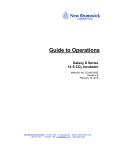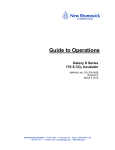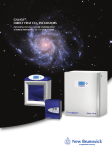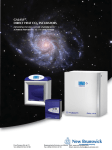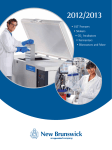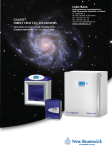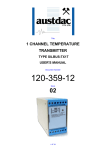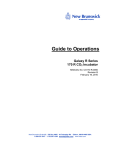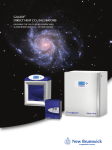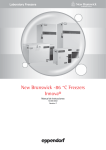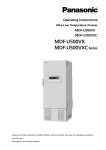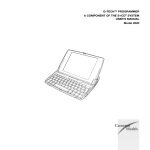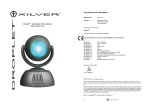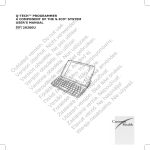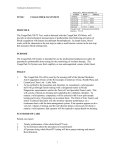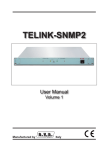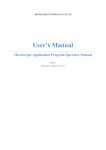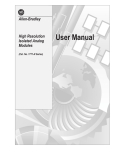Download Guide to Operations
Transcript
Guide to Operations Galaxy S Series 48 S CO2 Incubator MANUAL No: CO48S-0050 Revision A February 16, 2010 New Brunswick Scientific PO Box 4005 44 Talmadge Rd. Edison, 08818-4005 USA 1.800.631.5417 1.732.287.1200 [email protected] www.nbsc.com 2 INTERNATIONAL OFFICES: BELGIUM New Brunswick Scientific NV-SA Stationsstraat 180/4 3110 Rotselaar België/Belgique Tel: +32 (0)16 56 28 31 Fax: +32 (0)16 57 27 53 E-mail: [email protected] GERMANY Eppendorf Vertrieb Deutschland GmbH New Brunswick Produkte Peter-Henlein-Strasse 2 D-50389 Wesseling-Berzdorf Deutschland Tel: +49 (0)2232 418 0 Fax: +49 (0)2232 418 155 E-mail: [email protected] CHINA New Brunswick Scientific A903 Yin Hai Building No. 250, Cao Xi Road Shanghai 200235, P.R. China Tel: +86 21 6484 5955 or 5966 Fax: +86 21 6484 5933 E-mail: [email protected] THE NETHERLANDS New Brunswick Scientific BV Kerkenbos 1101, 6546 BC Nijmegen Nederland Tel: +31 (0)24 3717 600 Fax: +31 (0)24 3717 640 E-mail: [email protected] FRANCE Eppendorf France SARL 60, route de Sartrouville 78230 Le Pecq France Tel: +33 (0)1 30 15 67 40 Fax: +33 (0)1 30 15 67 45 E-mail: [email protected] UNITED KINGDOM New Brunswick Scientific (UK) Ltd. 17 Alban Park, Hatfield Road St. Albans, Herts. AL4 0JJ United Kingdom Tel: +44 (0)1727 853 855 Fax: +44 (0)1727 835 666 E-mail: [email protected] CO48S-0050 Galaxy S Series 48 S Personal Size CO2 Incubator User’s Guide 3 CAUTION! This equipment must be operated as described in this manual. If operational guidelines are not followed, equipment damage and personal injury can occur. Please read the entire User’s Guide before attempting to use this incubator. Do not use this equipment in a hazardous atmosphere or with hazardous materials for which the equipment was not designed. New Brunswick Scientific (NBS) is not responsible for any damage to this equipment that may result from the use of an accessory not manufactured by NBS. New Brunswick Scientific User’s Guide 4 Copyright Notice New Brunswick Scientific Box 4005 44 Talmadge Road Edison, New Jersey 08818-4005 Copyright 2010 New Brunswick Scientific All Rights Reserved. Reproduction, adaptation, or translation without prior written permission from New Brunswick Scientific is prohibited. Disclaimer Notice New Brunswick Scientific reserves the right to change information in this document without notice. Updates to information in this document reflect our commitment to continuing product development and improvement. Manual Conventions NOTE: CAUTION! WARNING! WARNING! Notes contain essential information that deserves special attention. Caution messages appear before procedures which, if caution is not observed, could result in damage to the equipment. Warning messages alert you to specific procedures or practices which, if not followed correctly, could result in serious personal injury. This particular Warning message represents a potential electrical hazard. This particular Warning message, whether found in the manual or on the incubator means HOT SURFACE–and therefore represents a potential danger to touch. CRUSH WARNING! Crush Warning messages alert you to specific procedures or practices regarding heavy objects which, not followed correctly, could result in serious personal injury. This symbol on the incubator is a reminder that it is of essential importance to read the user manual. CO48S-0050 Galaxy S Series 48 S Personal Size CO2 Incubator User’s Guide 5 WARRANTY Every Instrument manufactured by New Brunswick Scientific (NBS) is warranted to be free from defects in material and workmanship. This apparatus, with the exception of glassware, lamps and electrodes (where supplied), is warranted for 2 years against faulty components & assembly and our obligation under this warranty is limited to repairing or replacing the instrument or part thereof which shall within 2 years following date of shipment prove to be defective after our examination. Incubator accessories are warranted for 1 year. This warranty does not extend to any NBS products which have been subjected to misuse, neglect, accident or improper installation or application; nor shall it extend to products which have been repaired or altered outside the NBS factory without prior authorization from New Brunswick Scientific. New Brunswick Scientific User’s Guide 6 CO48S-0050 Galaxy S Series 48 S Personal Size CO2 Incubator User’s Guide 7 TABLE OF CONTENTS 1 INTRODUCTION .............................................................................................................. 9 2 UNPACKING & INSTALLATION ............................................................................... 11 2.1 2.2 2.3 2.4 2.5 2.6 3 INSPECTION OF BOXES ................................................................................................. 11 UNPACKING ................................................................................................................. 11 UTILITIES .................................................................................................................... 12 LOCATION ................................................................................................................... 13 INSTALLING THE FEET ................................................................................................. 13 SETTING UP ................................................................................................................. 14 OPERATION.................................................................................................................... 17 3.1 CONTROL PANEL ......................................................................................................... 17 3.2 PREPARING FOR OPERATION ........................................................................................ 18 3.3 USING THE HUMIDITY TRAY & HUMIDITY CONTROL .................................................. 18 3.4 SETTING TEMPERATURE & CO2 .................................................................................. 19 3.5 REFERENCING CO2 WITH AUTOZERO .......................................................................... 20 3.6 CO2 RECOVERY ........................................................................................................... 21 3.7 PROGRAMMING THE ALARM SYSTEM .......................................................................... 22 3.7.1 Setting High & Low Temperature Alarms.......................................................... 22 3.7.2 Setting the CO2 High & Low Alarms .................................................................. 22 3.7.3 Door Open Alarm............................................................................................... 22 3.7.4 Alarm Duration .................................................................................................. 23 3.7.5 Alarm Arming Delay........................................................................................... 23 3.8 CHAMBER ALARM SYSTEM ......................................................................................... 23 3.8.1 Temperature Sensor System Alarms................................................................... 25 3.8.2 Over-Temperature Cut-out & Alarm.................................................................. 26 3.8.3 CO2 Control System Alarm................................................................................. 26 3.8.4 Review of Alarm Messages................................................................................. 27 4 ROUTINE MAINTENANCE.......................................................................................... 28 4.1 4.2 4.3 5 GENERAL NOTES ......................................................................................................... 28 DAILY CHECKS ............................................................................................................ 28 MONTHLY CHECK ....................................................................................................... 28 CLEANING & DISINFECTING.................................................................................... 30 5.1 5.2 CLEANING ................................................................................................................... 30 DISINFECTING .............................................................................................................. 30 6 SPECIFICATIONS .......................................................................................................... 33 7 OPTIONS & ACCESSORIES......................................................................................... 35 7.1 7.2 OPTIONS ...................................................................................................................... 35 AVAILABLE ACCESSORIES ........................................................................................... 35 New Brunswick Scientific User’s Guide 8 8 DRAWINGS & TABLES................................................................................................. 36 8.1 8.2 LIST OF DRAWINGS...................................................................................................... 36 LIST OF TABLES ........................................................................................................... 36 9 CE CERTIFICATION..................................................................................................... 37 10 INDEX .............................................................................................................................. 38 CO48S-0050 Galaxy S Series 48 S Personal Size CO2 Incubator User’s Guide 9 1 INTRODUCTION The Galaxy 48 S CO2 incubator is microprocessor controlled and designed to ensure accurate and reliable operation. The incubator incorporates a simple, door-mounted touch-sensitive keypad with two individual three-digit LED displays that allow for easy programming and monitoring of the chamber conditions. A direct heating system, utilizing a thermal heating element, completely surrounds the incubator, providing an even temperature within the seamless chamber. The independently and directly heated outer door is designed to ensure an even distribution of heat. This system ensures a rapid, controlled return to optimum chamber conditions after a door opening while also preventing any overshoot. The incubator’s direct heat system provides for optimal use of laboratory space by allowing the most efficient internal volume for the footprint of the instrument. A viewing window within the door allows for sample viewing without disturbing chamber conditions. A solid-state infrared sensor is used to control the level of CO2, providing excellent reliability and remaining unaffected by humidity. The CO2 system has a programmable automatic zero system (AutoZero) to re-reference the sensor baseline to atmospheric CO2 levels at regular intervals. A small pump supplies HEPA-filtered atmospheric gas to the sensor. The chamber atmosphere within the sensor is completely displaced, allowing the control system to automatically reference the sensor, after which the pump is switched off, allowing the chamber atmosphere to homogenize back into the sensor. This provides for accurate CO2 control without disturbing the chamber environment. An independently controlled water tray at the bottom of the incubator allows a high, uniform relative humidity while preventing condensation in other parts of the chamber. Perforated shelves are provided as standard to facilitate recovery of RH conditions in the chamber. The seamless 48-liter chamber and all internal components are manufactured from polished stainless steel. The shelves (which are non-tip), shelf racks and humidity tray are easily removed without tools for thorough cleaning and are capable of being sterilized. Air circulation is achieved without the use of a fan, eliminating ductwork (a potential source of contamination), simplifying cleaning, eliminating vibration, and reducing small sample evaporation within the chamber. The outer shell of the incubator is manufactured from powder-painted steel for a durable finish. New Brunswick Scientific User’s Guide 10 The Galaxy 48 S model contains many standard features usually seen as options. In addition to its viewing window to allow visualization of the cultures without compromising the internal atmosphere, there is a 25mm access port now standard to allow for seamless integration of independent probes or other equipment through the chamber. NBS has also included an RS232 port as standard on all Galaxy S series incubators. This port will communicate with any computer through a hyperlink access or can be used to externally datalog the incubator through NBS software. The incubator incorporates a two-level alarm system. The chamber-monitoring alarms are programmable and will alert you if temperature or CO2 have not recovered within a preset time after the door has been opened. If it is not required, this system can be disarmed. The system alarms occur only if a system component problem has developed that requires user intervention to rectify. The incubator also incorporates an over-temperature safety system that operates independently from the main control system. CO48S-0050 Galaxy S Series 48 S Personal Size CO2 Incubator User’s Guide 11 2 UNPACKING & INSTALLATION 2.1 Inspection of Boxes After you have received your order from New Brunswick Scientific, inspect the boxes carefully for any damage that may have occurred during shipping. Report any damage to the carrier and to your local NBS Sales Order Department or distributor immediately. 2.2 Unpacking CRUSH WARNING! At least two people are required to safely lift your 48 S. Disassemble the wooden shipping crate and remove the protective packing. Save the packing materials for possible future use, and be sure to save this User’s Guide for instruction and reference. CAUTION! NEVER try to lift the incubator by its door; this would cause permanent damage to the incubator. NEVER lean on or place objects on the open door. To simplify lifting the incubator, leave it on the pallet. You must have at least one person at either side to safely lift the incubator. Supported by the base only, remove the incubator by lifting it from the delivery pallet. Locate and remove the parts stored in the Humidity Tray. If any part of your order was damaged during shipping, is missing, or fails to operate, please fill out Customer Satisfaction Form 6300 (packed in the envelope with your warranty card) and return it by fax or mail. You can also call New Brunswick Scientific’s or your distributor’s service department. Using your NBS packing list, verify that you have received the correct materials and that nothing is missing. Table 1 outlines the accessory items that are supplied with your new incubator: New Brunswick Scientific User’s Guide 12 Table 1: Accessories Provided Quantity Item Notes 3 Non-tip Shelves Packed Separately 2 Wire Shelf Racks Packed Separately 1 Humidity Tray Packed Separately 14 Silicone Rubber Suction Feet Installed 1 White porous CO2 Sensor Cover Installed 1 Black Sensor Cover* Installed 1 Power Cord Packed in accessories bag 3 meters, PVC Tubing, ~1/4-inch or 6mm bore, with an Packed in accessories bag 9.8 feet inline CO2 HEPA-filter connected, ready for use 2 Hose Clips Packed in accessories bag 1 AutoZero HEPA Filter Packed in accessories bag 4 Adjustable Feet Packed in accessories bag 4 Anti-slip Pads for adjustable feet Packed in accessories bag 1 User Manual Provided * There is a holder at the rear of the incubator to store the black sensor cover. WARNING! Anytime you touch or handle the white CO2 sensor cover, be sure to wear gloves, and do not later touch those gloves to your face. Discard or wash the gloves. 2.3 Utilities In order to use the incubator, you will need: Table 2: Utilities Utility Electricity CO2 Gas Requirement 100/120V, 50/60 Hz grounded electrical supply with minimum capacity of 6 amps (or 8 amps for High Temperature Disinfection Models) OR 220/240V, 50 Hz grounded electrical supply with minimum capacity of 3 amps (or 5 amps for High Temperature Disinfection Models) Cylinder with 100% CO2 vapor withdrawal, together with a two-stage regulator for pressure control to 5 psi or 0.35 bar WARNING! For proper incubator operation, CO2 gas pressure must not exceed 5 psi. CO48S-0050 Galaxy S Series 48 S Personal Size CO2 Incubator User’s Guide 13 2.4 Location The incubator is designed to operate at a chamber temperature of 4.0°C above ambient, and at an absolute minimum ambient temperature of 15°C if the incubator is being used at 37°C. Care should be taken to avoid placing the incubator in a position that may affect its performance, such as those listed below. NOTE: For optimum performance, maintain ambient operating temperature within the range of 18-24°C. DO NOT place the incubator: Directly under, beside or within the air-flow of heating or air-conditioning ducts, or other drafts; Directly beside heat-generating equipment such as a heater, an autoclave or an oven; Near the exhaust of heat- or cold-generating equipment (like a –86oC freezer); Near a window exposed to direct, unshaded sunlight. Place the incubator in the working position, on a level surface capable of bearing its weight of approximately 70.5 lbs/32 kg (actual use weight will be heavier and will depend on the options installed and the material stored in the incubator). The incubator is not designed to be directly stackable. A second incubator may be safely stacked on top of another identical incubator by using the custom-designed stacking stand available as an accessory for the Galaxy 48 S. It is not possible to put any other type of incubator or heavy apparatus on top, as the top cover and stacking stand were not designed to support any other device. 2.5 Installing the Feet To ensure adequate airflow for correct operation of the relative humidity control system the incubator feet must be installed. More than one person is required to perform this operation. To insert the adjustable feet: 1. If they are not already installed, install the locking nuts onto each of the four feet provided. 2. Beginning with the front pair: tilt the incubator toward the back, and screw the feet in, to the required depth. 3. Tilt the incubator forward to install the rear pair of feet. 4. Put an anti-slip pad (provided) on each foot and keep them installed at all times. New Brunswick Scientific User’s Guide 14 2.6 Setting Up Install the power cord: 1. Insert the power cord into its receptacle on the back on the incubator. 2. Press the cord firmly into its socket. Install the shelf racks and shelves, and level the incubator: 1. Each wire shelf rack has silicone suction cups that hold the rack in place. Install the silicone suction cups onto the wire rack supports (7 per rack, each marked with an asterisk in Figure 1a below). 2. Note that there are lefthand and righthand racks. The suction cup marked R (“Rear”) goes to the rear of the chamber as shown in Figure 1b below. The suction cups will adhere to the chamber walls even if they are dry; but if you feel it is necessary, you can dampen them with distilled water to increase adhesion. 3. Ensure the shelf racks are installed squarely in the chamber so the shelves will sit on a level plane (see Figure 1c below). Figure 1: Installing Shelf Racks R a b c 4. Install the three shelves, making sure that each shelf’s anti-tip tab is properly inserted onto each of the wire shelf rack guides (see Figure 2 below). CO48S-0050 Galaxy S Series 48 S Personal Size CO2 Incubator User’s Guide 15 Figure 2: Installing Shelves 1 1 Anti-tip tab 5. Level the incubator by adjusting the feet. Place a small level on the second shelf of the incubator. Adjust the leveling feet until the incubator is level and stable. Lock the leveling legs in place by tightening the locking nuts on each leg. Install the humidity tray: 1. Install the humidity tray in its location beneath the lowest shelf rack position: insert the tray diagonally (see Figure 3a), then turn the tray 45 as shown, until you can set it in position, resting on the chamber floor, with its front and rear edges resting just above the shelf rack supports (see Figure 3b). Figure 3: Installing/Removing the Humidity Tray 1 a b 1 New Brunswick Scientific Center the tray, making sure it sits within the rack supports. User’s Guide 16 Connect the CO2 gas supply: WARNING! Slightly increased levels of CO2 may be found in and around the operating area of the CO2 incubator. Over time, this can have adverse effects on those exposed to such an environment. Users working in environments with elevated levels of CO2 should take all appropriate precautions to protect their breathing. 1. Connect the incubator to the CO2 supply using the ~1/4-inch or 6mm plastic tubing (with installed HEPA filter) by attaching the tubing from the two-stage regulator (or in-line regulator) to the matching CO2 inlet on the rear of the incubator. NOTE: It is highly recommended that an in-line regulator be used at the incubator’s gas inlet(s). For proper incubator operation, CO2 gas pressure must not exceed 5 psi (0.35 bar). 2. Use the tubing clips provided to eliminate CO2 leaks. Install the HEPA AutoZero filter: 1. Press the AutoZero HEPA filter gently into the white plastic filter socket at the top of the rear panel of the incubator (see Figure 4). Figure 4: AutoZero HEPA Filter & Fitting CO48S-0050 Galaxy S Series 48 S Personal Size CO2 Incubator User’s Guide 17 3 OPERATION 3.1 Control Panel The control panel consists of two LCD displays and four function keys (see Figure 5): Figure 5: Control Panel 1 2 3 1 Temperature display 2 CO2 display 3 Function keys Table 3: Function Keys Key Symbol Key Name Programming Down Up enter Enter Function Press this key to enter Programming mode, and to set values in either display. Press this key simultaneously with the Enter key to perform AutoZero. In Programming mode, use this key to scroll down through numbered values in the display. Press this key simultaneously with the Enter key to work in the Alarm system. In Programming mode, use this key to scroll up through numbered values in the display. Press this key to save a new setpoint. Press this key simultaneously with the Programming key to perform AutoZero. Press this key simultaneously with the Down key to work in the Alarm system. NOTE: If you accidentally press both the Up and Down keys simultaneously, you will engage Engineering Mode: immediately press the Programming key ( ) to exit. New Brunswick Scientific User’s Guide 18 3.2 Preparing for Operation 1. Remove the black protective cover from the CO2 sensor (located on the back surface of the internal chamber), and store it for use when you clean the incubator. There is a storage holder for the cover on the back on the incubator. 2. Ensure that the white porous sensor cover remains in place. 3. Using the power cord provided, connect the incubator to a grounded power supply. 4. Switch the incubator ON using the on/off switch at the rear of the cabinet. The display will illuminate immediately. 5. Turn on the CO2 gas supply with the pressure regulator set to 5 psi or 0.35 bar. NOTE: Be certain to check for leaks in the CO2 connections to avoid depleting your CO2 gas supply. This can be accomplished using a solution of soapy water applied to each fitting and checking for bubbles. If any bubbles are noted, readjust the fitting. 6. The chamber setpoints are pre-programmed at 37.0°C and 5% CO2. Leave the incubator on until the programmed chamber temperature and CO2 concentration has been reached (please see NOTE below). NOTE: The incubator’s CO2 valve is disabled until the incubator reaches the temperature setpoint. After reaching the temperature setpoint, the CO2 valve is activated, allowing the incubator to reach the CO2 setpoint. If power is interrupted to the incubator long enough for the temperature to drop below setpoint, the CO2 valve will be deactivated until setpoint is again achieved. (This serves to avoid spurious CO2 readings while the incubator is reaching its temperature setpoint) 7. Leave the incubator running for at least two hours (preferably overnight) to allow conditions to stabilize. 3.3 Using the Humidity Tray & Humidity Control If humidification is required, the humidity tray should be filled with 0.5 liters of warm ( 37.0ºC) distilled water at this time. For cell culture work, we recommend the use of copper sulphate (or a recognized biocide) in the humidity tray. Tests have shown that, in addition to inhibiting bacterial growth in the tray, this can reduce contamination on the chamber walls. Add one small teaspoonful (~0.11 oz or 3.2 g) of copper sulphate each time you fill the tray with fresh water. CO48S-0050 Galaxy S Series 48 S Personal Size CO2 Incubator User’s Guide 19 For IVF and other sensitive work, we do not recommend the use of any biocide in the humidity tray. To reduce the possibility of contamination, every 10 to 14 days, empty the tray, clean it with a solution of 70% isopropyl alcohol and 30% distilled water, and then refill it with 0.5 liters of warm distilled water. To remove the humidity tray, turn it 45º to clear the shelf rack supports (see Figure 3a). CAUTION! Never leave water in the humidity tray while the incubator is switched off, or when a high temperature disinfection cycle is initiated, to avoid possible damage to the CO2 sensor. The humidity level within the chamber can be manually adjusted from ~95% to ~97%. The controller to adjust the humidity level is found on the lower, front right side of the instrument. The black adjustment knob can be rotated clockwise for standard (~95%) humidity levels, and counter-clockwise to increase the humidity level. NOTE: The humidity tray should always be left in place, even if the incubator is not being humidified. 3.4 Setting Temperature & CO2 At this time, program the desired Temperature and CO2 setpoints. Temperature and CO2 may be set within the following ranges: Table 4: Temperature & CO2 Setpoint Ranges Parameter Temperature CO2 Available Setpoint Range 10ºC to 50ºC (must be at least 4ºC above ambient) 0.2% to 20% To set the Temperature: 1. Press the Programming ( ) key. 2. Press the Up ( ) or Down ( ) key until the desired value appears in the lefthand display. 3. Press the enter key to save the setpoint. 4. Now you can set the CO2 level. New Brunswick Scientific User’s Guide 20 To set the CO2 level: 1. Press the programming ( ) key. 2. Press the up ( ) or down ( ) key until the desired value appears in the righthand display. 3. Press the enter key to save the setpoint. If at any time you wish to change the CO2 level without adjusting the Temperature setpoint, press the Programming ( ) key twice to work in the CO2 display. NOTE: CO2 gas will NOT be injected until the incubator reaches its temperature setpoint. Allow the incubator to stabilize at the selected setpoints for at least 2 hours before continuing. 3.5 Referencing CO2 with AutoZero The purpose of the AutoZero system is to reference the CO2 sensor to an atmospheric CO2 level of 0.05%. Over a period of time, the sensor baseline may drift, causing an inaccuracy in the CO2 level at the programmed value. We recommend that you AutoZero the CO2 system: Prior to using the incubator for the first time Once a month when your incubator is operating, to ensure that the CO2 level is as accurate as possible After the incubator has been in storage (or transit) for a while. To perform the AutoZero: 1. If you have not already done so, set the CO2 level (see Section 3.4). There should be an audible click when the programmed level is entered: this is the CO2 valve opening. 2. Press the and enter keys simultaneously. NOTE: There is a magnetic switch above the door, and a magnet mounted in the door, to switch off the CO2 valve when the door is opened. 3. The door (and inner doors, if present) must be opened and closed according to the displayed instructions, after which the process is completely automatic. 4. Open the door for 60 seconds to completely degas the chamber. A countdown is shown on the display. CO48S-0050 Galaxy S Series 48 S Personal Size CO2 Incubator User’s Guide 21 5. When the display instructs you to do so, close the door. An automatic 10-minute countdown will start, to allow the chamber conditions to recover and the CO2 sensor signal to stabilize. 6. At the end of the countdown, the sensor signal will automatically be re-referenced. The incubator will reopen the CO2 valve to allow the CO2 level to recover to the setpoint value. NOTE: Pressing any key, or opening the door during the AutoZero will automatically terminate the process and control of CO2 will restart. The incubator is now ready for use. 3.6 CO2 Recovery After a door opening, it should be possible for the actual CO2 level to recover to around 4.8% in 2 to 2.5 minutes. The displayed CO2 level takes 30 to 45 seconds more to catch up with the actual level. This is because it takes approximately 45 seconds from the time the gas enters the chamber to fully mix and become uniform inside the sensor. The graph below (Figure 6) shows typical results for door openings between 10 and 45 seconds. The control system does this is by speeding the sensor reaction time when the door is opened and then slowing it down to produce a more accurate reading after the setpoint level is achieved. Figure 6: Actual vs. Displayed CO2 Levels New Brunswick Scientific User’s Guide 22 3.7 Programming the Alarm System 3.7.1 Setting High & Low Temperature Alarms 1. Press the enter & keys simultaneously to enter the alarm menu. The display will show . . 2. Press the enter key to display the High Temperature Alarm, . . The factory setting is the setpoint value (37.0ºC) + 0.5 C. 3. If you wish to adjust the High Temperature Alarm, use the or key. The minimum setting, however, is 0.5 C from setpoint. 4. Press the enter key to save the setting, whether or not you have changed it. Now the Low Temperature Alarm is displayed, . . The factory setting is the setpoint value (37.0ºC) - 0.5 C. 5. Use the or key if you wish to adjust the value. 6. Press the enter key to accept the setting, whether or not you have changed it. 3.7.2 Setting the CO2 High & Low Alarms 1. While you are still in the alarm menu (see Step 1 of Section 3.7.1 above), press the key. The display will show . 2. Press the enter key to display . . . The factory setting is the setpoint value (5.0%) + 0.5%. 3. If you wish to adjust the High CO2 Alarm, use the or key. The minimum setting, however, is 0.5 C from setpoint. 4. Press the enter key to save the setting, whether or not you have changed it. Now the Low CO2 Alarm is displayed, . . The factory setting is the setpoint value (5.0%) - 0.5%. 5. Use the or key if you wish to adjust the value. 6. Press the enter key to accept the setting, whether or not you have changed it. 3.7.3 Door Open Alarm When you open the door, an alarm will sound after a preset time delay. If you wish to adjust the time delay: 1. In the alarm menu (see Step 1 of Section 3.7.1 above), press the key, the display will show . (reading across both displays). 2. Press the enter key and the & keys to adjust the time (as you scroll through the available choices, you will see , , , , & seconds, then ). CO48S-0050 Galaxy S Series 48 S Personal Size CO2 Incubator User’s Guide 23 3. Press the enter key to save the desired value. 3.7.4 Alarm Duration The following steps will adjust the length of time during which all audible alarms will last: 1. In the alarm menu (see step 1 of Section 3.7.1 above), press the key. The display shows . (reading across both displays). 2. Press the enter key and the & keys to adjust the Alarm duration (as you scroll through the available choices, you will see , , , , , , then ). 3. Press the enter key to select the desired value. 3.7.5 Alarm Arming Delay This is the length of time that is allowed for the Temperature and CO2 to recover after you open the incubator, and before the Alarm System is armed again. This helps prevent unnecessary alarms from occurring. To change the delay: 1. In alarm menu (see step 1 of Section 3.7.1 above), press the key. The display will show . (across both windows). 2. Press the enter key and the & keys to adjust the Alarm Arming time (as you scroll through the available choices, you will see . , . , . , . , then ). 3. Press the enter key to select the desired value. Press to return to the main alarm programming menu, and press return to the main display. again to NOTE: When alarm delay is set to OFF, the Alarms will arm only when the programmed setpoint is reached. 3.8 Chamber Alarm System When the incubator is switched ON, or after any values have been reprogrammed, the Alarm System is inactive until the setpoint values (± 0.1) are achieved, after which the Alarm System is armed. See Figure 7, Chamber Alarm System Flow Chart, on the following page. New Brunswick Scientific User’s Guide 24 If temperature and/or CO2 levels deviate more than the programmed amount, the display flashes, the audible alarm sounds and a message appears on the screen. You can acknowledge (and cancel) the alarm by pressing any key. When the inner door (if fitted) is opened, the Alarm System is disabled. When you close the outer door, the preset Alarm Arming Delay starts. When the delay time expires, the Alarm System is rearmed; if the temperature and/or CO2 should fall below or rise above the alarm setpoints, the alarm will be activated. If chamber conditions recover within the Alarm Arming Delay time, the Alarm System will be rearmed but no alarm will be activated. If an alarm is not acknowledged but the chamber conditions subsequently recover, the audible alarm will be cancelled but the alarm message will remain on the screen to alert the user to the fact that an alarm has occurred. You can cancel this alarm message by pressing any key. The duration of the audible alarm can be adjusted from inactive to continuous (see Section 3.7.4 above). CO48S-0050 Galaxy S Series 48 S Personal Size CO2 Incubator User’s Guide 25 Figure 7: Chamber Alarm System Flow Chart OPEN INNER DOOR CHANGE PROGRAMMED VALUES SWITCH ON DISARM ALARMS CLOSE INNER DOOR ARE TEMPERATURES AND CO2 LEVELS WITHIN +/- 0.1 OF SET POINT? 15 MINUTES ALARM DELAY TIMEOUT STARTED NO YES 15 MINUTES ALARM DELAY TIMEOUT COMPLETED ARM ALARMS IS TEMPERATURE OR CO2 LEVEL MORE THAN +/- 0.5 OUTSIDE PROGRAMMED POINTS? YES NO VISIBLE AND AUDIBLE ALARM - MESSAGE ON SCREEN CANCEL ALARM BY PRESSING ANY KEY ALARMS CANCELLED NO HAVE CONDITIONS RECOVERED TO WITHIN +/- 0.1? 3.8.1 YES VISUAL AND AUDIBLE ALARMS CANCELLED, MESSAGE LEFT ON SCREEN CANCEL MESSAGE BY PRESSING ANY KEY Temperature Sensor System Alarms There are four temperature sensors: two in the door and two in the chamber. If any of these sensors should fail, the following message will appear: . Because the incubator can no longer control temperature properly without the failed sensor, the heating will switch off and the incubator will cool down to room temperature. New Brunswick Scientific User’s Guide 26 If, however, a sensor fails but subsequently corrects itself, the temperature control will restart and an alarm message will remain on the temperature side of the display: ... (meaning Sensor Alarm). This message can be cancelled by pressing any key. 3.8.2 Over-Temperature Cut-out & Alarm This alarm only occurs if the chamber temperature exceeds the Temperature setpoint by 1°C or if one of the heating elements exceeds a specific activation threshold. The activation threshold is set at the factory and cannot be adjusted. Following activation, the over-temperature cut-out & alarm system operates in two sequential modes: Mode 1: The over-temperature cut-out & alarm activates and cuts power to the heating elements and the CO2 control valve. The condition is shown on the display by the message . When the chamber temperature has fallen to the programmed setpoint, the system changes to Mode 2. Mode 2: The control system then tries to maintain the chamber temperature at the programmed level by switching the heating elements on and off, using an emergency control method that is, however, less precise. The message will flash on-screen to signal that an over-temperature fault occurred and the incubator is being controlled by the emergency control system. This message cannot be cancelled via the keypad. Normal temperature control can be regained and the over-temperature cut-out & alarm can be cancelled by reprogramming the temperature, opening and closing the door, or switching the incubator off and then back on. If the problem persists, the alarm will recur; if this happens, please contact your service representative or your distributor immediately. 3.8.3 CO2 Control System Alarm This alarm only occurs if the CO2 AutoZero cannot reference the sensor signal to atmosphere. If this is the case, at the end of the AutoZero procedure, the following message will appear: . This means that the CO2 sensor is defective and requires replacement. If this alarm occurs, contact your service representative immediately. CO48S-0050 Galaxy S Series 48 S Personal Size CO2 Incubator User’s Guide 27 3.8.4 Review of Alarm Messages For easy reference, Table 5 provides an overview of all alarm messages that you may encounter across both displays. Table 5: Alarm Messages Message . New Brunswick Scientific Meaning door open temperature sensor failure sensor alarm after sensor recovers over-temperature cut-out has cut power to heating elements and CO2 valve over-temperature defect has occurred and system is under emergency control CO2 sensor is defective and needs to be replaced Ref. Section 3.7.3 3.8.1 3.8.1 3.8.2 3.8.2 3.8.3 User’s Guide 28 4 ROUTINE MAINTENANCE 4.1 General Notes To ensure that chamber conditions remain as stable as possible, minimize the length of time that the door is open. The magnetic door catches are specifically designed to make door opening and closing as easy as possible. When you open the door, wipe off any small drops of condensate that may have formed on the inner seal. This will avoid a build-up of condensation. If you are using the humidity tray for humidification, be sure to follow the indications provided in Section 3.3. 4.2 Daily Checks 1. Check that the temperature and CO2 levels are reading within specification. 2. Check the reserve pressure in the CO2 cylinder (normally 725 psi or 50 bar when full). The design of the incubator ensures very low consumption of CO2: during normal working conditions, a typical large cylinder should last approximately 12 months (frequent door openings will deplete the supply more rapidly, however). If there is a significant drop at the cylinder pressure of 725 psi or 50 bar, it means that the cylinder is almost empty and should be replaced. Making certain that there are no leaks at any of the connections will ensure a greater lifetime to the CO2 supply and will help avoid accidentally running out of CO2. 3. Any spills in the chamber should be cleaned immediately to protect the stainless steel surfaces. 4.3 Monthly Check Remember that we recommend routine replacement of the water in the humidity tray, and that you clean the tray at the same time. 1. If you are not changing the humidity tray water and cleaning the humidity tray regularly, you should at least fill the humidity tray once a month. Do not, however, exceed the maximum volume of 0.5 liters. Use warm water (~37.0°C) to ensure a rapid return to optimum chamber conditions. After adding water, check that the humidity tray is centered between the shelf rack supports. CO48S-0050 Galaxy S Series 48 S Personal Size CO2 Incubator User’s Guide 29 2. If required, you can take a sample of the gas inside the chamber using the CO2 sample port, and check it using a CO2 gas analyzer. The CO2 sample port is located at the top of the rear panel. If you conduct a sampling, please do the following: Turn off the CO2 gas by re-programming the setpoint for CO2 to 0.0% to prevent CO2 from being injected into the chamber and giving a false reading. Use a flow rate that is 0.5 liters/minute to take a sample. Keep the door closed to minimize heat loss. Remember to reset the CO2 setpoint to the desired level after sampling. We recommend that you perform a CO2 AutoZero prior to sampling (see Section 3.5). 3. We also recommend that you AutoZero the CO2 system at least once every 28 days to ensure that CO2 level is correct. New Brunswick Scientific User’s Guide 30 5 CLEANING & DISINFECTING 5.1 Cleaning 1. Routinely clean the exterior of the incubator by wiping it over with a soft cloth, moistened with soapy water. 2. Rinse the soap from the cloth in clean water, and wipe the exterior surfaces again. CAUTION! Be sure to use only approved cleaning fluids and materials. Solvents, chloride-based cleaning substances and abrasive materials, among others, may cause permanent damage to the product surfaces. Also be sure to wipe all surfaces dry, leaving them free from any foreign particulates or fluids which could cause subsequent surface damage. (See the CAUTIONs in Section 5.2). 5.2 Disinfecting The recommended disinfecting agent for use with the incubator is a solution of 70% isopropanol (isopropyl alcohol) and 30% distilled water. Be sure to follow appropriate safety regulations while you are using this solution: WARNING! As a routine precaution, wear protective gloves. Be sure to adequately ventilate the work area as you are disinfecting, to avoid the formation of potentially explosive alcohol vapors. Protect all electrical connections from contact with the alcohol solution. To best protect yourself, your incubator and your work area, follow these instructions: 1. Program 0.0% CO2 and switch off the incubator. Unplug the incubator from the power supply. CO48S-0050 Galaxy S Series 48 S Personal Size CO2 Incubator User’s Guide 31 2. Dampen a clean cloth with the alcohol solution and wipe down all external surfaces, taking care to keep the alcohol solution from coming into contact with any electrical outlets or assemblies. 3. Remove all of the shelves, the humidity tray and the shelf racks. 4. Place the black protective cover over the CO2 sensor. Also protect any additional sensors, such as Oxygen or Humidity, with the cover(s) supplied. CAUTION! It is very important to ensure that no liquid is spilled onto the white porous CO2 sensor cover at the rear of the chamber. Failure to use the protective cover(s) could result in damage to the sensor(s) and may affect your warranty. 5. You can clean the humidity tray by rinsing it in sterile water, wiping it down with the alcohol solution, and then rinsing it with sterile water. 6. Wipe down the inside of the chamber with the alcohol solution, and leave it to dry completely. CAUTION! Never use any of the following substances to clean the stainless steel, or damage will result: Sodium Azide, Aqua Regia, Iodine, Ferric Chloride or Sulphuric Acid. 7. Wipe the internal components of the chamber twice with the alcohol solution. Wipe off excess liquid and leave it to dry completely. 8. Reassemble the shelf racks and the shelves before switching the incubator on. Wipe the inside door seal with the alcohol solution, rinse and leave to dry. 9. Taking care to leave the white porous cover(s) in place, be sure to remove the black protective cover(s) from the sensor(s) and place them in the holder at the rear of the incubator for safekeeping (protective covers must also be removed from any additional sensors installed, such as Oxygen or Humidity). 10. Refill the humidity tray (as explained in Section 3.3). When you reinstall it, ensure that the humidity tray is centered between the shelf rack supports. New Brunswick Scientific User’s Guide 32 11. Leave the incubator on for at least two hours (preferably overnight) to allow conditions to stabilize. 12. When the incubator has stabilized, carry out an AutoZero and reprogram the desired CO2 level. It may be necessary to open the glass door briefly if, after performing an AutoZero, the CO2 level is too high. CO48S-0050 Galaxy S Series 48 S Personal Size CO2 Incubator User’s Guide 33 6 SPECIFICATIONS Table 6: Specifications Galaxy 48 S Incubator Specifications Digital programming via microprocessor control on 0.1°C increments. Measurement of chamber and door temperature via 4 RT* matched thermistors (sensitivity Temperature Management 0.01°C) Adjustable independent control of door heater “Out of Limits” temperature protection system independent of microprocessor control. Range 4°C above ambient temperature to 50°C Control 0.1°C Stability ± 0.1°C Uniformity ± 0.3°C Solid-state infrared CO2 sensor operating independent of CO2 Control humidity. Programmable, semi-automatic zeroing function. Range: 0.2 - 20% Control: ± 0.1% Stability: ± 0.2% Uniformity: ± 0.1% Recovery Rate: Better than 1.5% minute Gas Connections: ~1/4-inch or 6mm tubing Required Gas Pressure: 5 psi / 0.35 bar Relative Humidity Removable stainless steel humidity tray Reservoir Capacity: 0.5 liters Normal: 90-95% at 37°C Humidity Control: manual High: 97% at 37°C Polished stainless steel, non-perforated (standard). Shelves Usable Area: 875cm2 per shelf Number of Shelves: 3 standard ; with Multiple Position Option, up to 6 shelves Two-level alarm system giving programmable audio/visual warnings with options for remote communication. Level 1 Alarm Systems signals system failures, level 2 is programmable and monitors chamber conditions. Seamless interior with removable door seal Dimensions Chamber (HxWxD): 401 x 401 x 308mm or 15.8 x 15.8 x 12.1 inches Chamber Volume: 48 liters or 1.7 cu ft External (HxWxD): 648 x 484 x 475mm or 25.5 x 19.1 x 18.7 inches 920 x 630 x 630mm or 36.2 x 24.8 x 24.8 inches (Including External, Crated (HxWxD): pallet) Crated: 50 kg/110.2 lbs Weight Uncrated: 32kg/70.5 lbs (with standard features) *RT = Resistance Temperature curve ...continued... New Brunswick Scientific User’s Guide 34 Galaxy 48 S Incubator Specifications Grounded Electrical Supply 100-120V 50/60Hz Voltage: or 220-240V 50/60Hz 500 watts, Standard models Power: 700 watts, High Temperature Disinfection models Energy to maintain 37°C: < 0.1kWh 10 - 50°C Storage Temperature . CO48S-0050 Galaxy S Series 48 S Personal Size CO2 Incubator User’s Guide 35 7 OPTIONS & ACCESSORIES 7.1 Options Some option combinations are not possible; others may incur extra cost. Please inquire before ordering. Table 7: Available Options Option NBS Part Number Split Inner Door Alarm Relay Contacts Internal Power Receptacle P0628-5330 P0628-5340 P0628-5350 Retrofittable in Field? No Yes No 7.2 Available Accessories Table 8: Available Accessories Accessory CO2 Bottle Automatic Change-Over Instrument CO2 Two Stage Regulator CO2 Supply Line Filters, HEPA In-Line Pressure Regulator CO2 Gas Analyzer Kit 10 Spare CO2 Gas Analyzer Tubes Air Zero Filters, HEPA (supplied in pairs) Non - Perforated Shelves Perforated Shelves Floor Stand & Stacking Frame, for double stacking Multi-position Shelf Racks (Max 6 positions) New Brunswick Scientific NBS Part Number P0628-5000 P0628-5010 P0628-5020 P0628-5030 P0628-5040 P0628-5050 P0628-5060 P0628-5070 P0628-5080 P0628-5090 P0628-5100 User’s Guide 36 8 DRAWINGS & TABLES 8.1 List of Drawings Following is a key to the illustrations in this manual: Figure 1 2 3 4 5 6 7 Description Installing Shelf Racks Installing Shelves Installing/Removing the Humidity Tray AutoZero HEPA Filter & Fitting Control Panel Actual vs. Displayed CO2 Levels Chamber Alarm System Flow Chart Page 14 15 15 16 17 21 25 8.2 List of Tables Following is a key to the tables in this manual: Table 1 2 3 4 5 6 7 8 CO48S-0050 Description Accessories Provided Utilities Function Keys Temperature and CO2 Setpoint Ranges Alarm Messages Specifications Available Options Available Accessories Galaxy S Series 48 S Personal Size CO2 Incubator Page 12 12 17 19 27 33 35 35 User’s Guide 37 9 New Brunswick Scientific CE CERTIFICATION User’s Guide 38 10 A Access Port, 10 Accessories, 35 Adjustable Feet Installing the, 13 Alarm Messages Recap of, 27 Alarm System Programming the, 22 Alarm Systems Specifications, 33 Alarms, 10 Arming Time Delay, 23 Duration of, 23 Anti-Slip Pads Installing the, 13 AutoZero, 10 Frequency, 29 Purpose of, 20 Running the, 20 AutoZero Failed Message, 26 C CAUTION Symbol for, 5 CE Certification, 37 Chamber Alarm System Functions of, 23 Chamber Alarms Flow Chart, 25 Checks Daily, 28 Monthly, 28 CO2 Control Specifications, 33 CO2 Control System Alarm, 26 CO2 High Alarm, 22 CO2 Low Alarm, 22 CO2 Setpoint Range, 19 Condensation, 28 CO48S-0050 INDEX Minimizing, 10 Control Panel, 17 Copyright Notice, 4 D Dimensions Specifications, 33 Direct Heating System, 9 Direction Keys, 17 Disclaimer Notice, 4 Door Open Alarm, 22 Drawing List, 36 E Electrical Supply Specifications, 34 F Function Keys, 17 G Gas Supply Connecting the, 15 H Harmful Substances, 31 HEPA Filter, 10 Installing the Auto-Zero, 16 Humidity Control, 10 Humidity Tray Filling the, 18 Installing the, 15 Removing the, 15 Using the, 18 I Infrared CO2 Sensor, 10 Inner Door, Heated, 10 International Offices List of, 2 Galaxy S Series 48 S Personal Size CO2 Incubator User’s Guide 39 L Location, 13 M Manual Conventions, 5 N NOTE Symbol for, 5 O Operating Notes, 28 Options Factory-Installed, 35 Retrofittable in Field, 35 Over-Temperature Safety, 10 Over-Temperature/Cut-Out Alarm, 26 Overview, 10 P Part Numbers, 35 Pressure Setting, 18 Service Parts, 35 Setpoints Factory-set, 18 Setting %CO2, 19 Setting Temperature, 19 Setup Concerns Issues to Avoid, 13 Shelves Specifications, 33 Specifications, 33 Storage Temperature Specifications, 34 T Table of Contents, 7 Temperature High Alarm, 22 Low Alarm, 22 Temperature Management Specifications, 33 Temperature Sensor System Alarms, 25 Temperature Setpoint Range, 19 U R Relative Humidity Specifications, 33 RS232 Port, 10 Utilities, 12 W S Sensor Cover, 31 New Brunswick Scientific WARNING Symbol for, 5 Warranty, 5 Weight Specifications, 33 User’s Guide







































